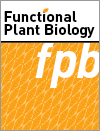Lodging occurs when crop stems bend permanently from their usual upright position, reducing yield. Lodging has been witnessed in various places worldwide, and its unpredictable nature makes it a substantial constraint for yield improvement.To better understand this process and determine the trait best correlated with lodging in wheat (Triticum aestivum), a study was conducted under both artificially-induced and natural lodging conditions. Genotypes were ranked, and we tried to standardise methodology for measuring lodging tolerance in an artificial environment.

Functional Plant Biology
Volume 51 Number 9 2024
Water relations strategy of plants is a complex but important trait in selecting cultivars and design management for adaptation to climate change. Among the possible estimating traits, those associated with the ‘fast-slow’ plant economics spectrum are interesting, regarding this, we observed an association between the water deficit tolerance of six fruit tree species and their leaf and wood density. These traits are easy to measure, time-cost efficient, and appear central to coordinating traits and behaviours along the water relations strategies.
Co-applying β-sitosterol and biochar improved drought resilience in Phaseolus vulgaris. Nutrient uptake and biochemical metrics increased in P. vulgaris with the combined effect of β-sitosterol and biochar. This approach enhances growth parameters, suggesting resilience to climate change.
The world population is increasing day by day. Cereals are a good source of energy for this increasing population. Climate changes exert pressure on agriculture and hinder overall production. Genome editing techniques such as CRISPR/Cas have been extensively used to improve crops. In this review, we summarise the different genome editing techniques, their advantages, and disadvantages.
This article belongs to the Collection Functional Genomics for Developing Climate Resilient Crops.
Glycoside hydrolases (GHs) are involved in plant defence, cell wall metabolism and stress response. A total of 366 GH superfamily genes were identified in potato (Solanum tuberosum). Differential expression analysis indicated the involvement of GHs in various tissues, abiotic stress and biotic stresses, with specific genes showing significant changes in expression levels under drought and salt stress. Real time qPCR analysis revealed that StGH16.24 expression increased significantly after 3 days of drought stress, validating the presence of ABRE, MYB and MYC cis-regulatory elements.
This article belongs to the Collection Functional Genomics for Developing Climate Resilient Crops.
The morphological and physiological adaptations of Agave species, including the Classulacean acid metabolism (CAM), allow plants to develop in arid and semi-arid environments. Four diel phases have been described in CAM plants that regulate carbon metabolism, growth and yield. The hypothesis is that in early-development plants from seeds, growing under greenhouse conditions, of each genotype’s physiological responses, including growth and metabolites concentrations, vary among CAM phases because of the species of Agave and the seed provenance.
There is limited information on the hybridisation of enzymes linked to these characteristics. Understanding hybrid dominance of photosynthetic traits and their associated enzymes in sorghum is crucial for identifying sorghum hybrids with highly dominant combinations and selecting suitable parents. This study utilised 36 sorghum hybrid F1 generations and their respective parents to assess hybrid dominance in leaf photosynthetic parameters, key enzyme activities during photosynthesis, yield formation, and other relevant factors, while also examining their correlation with yield in field conditions.
This article belongs to the Collection Machine Learning for Plant Stress Phenotyping.
FP24135 Abstract | FP24135 Full Text | FP24135PDF (2 MB) Open Access Article
Floating agriculture is a promising way of crop cultivation under submergence. Production of chilli (Capsicum annuum), an important spice crop, is greatly affected by waterlogging. In submerged conditions, floating agriculture serves an alternative agronomic means of chilli cultivation.
Priming is a method where the exposition of a plant to a mild stress before a severe one enables quicker stress response, and holds promise in mitigating water stress. This study assessed the efficacy of priming in combating waterlogging and dehydration in soybean (Glycine max) plants. Results revealed that priming significantly boosted antioxidant enzyme activity and organic compound levels while reducing oxidative damage. Such findings suggest that priming could help soybean cultivation, enhancing resilience against climate-induced adversities and ensuring global food security.
ERECTA (ER) protein plays a crucial role in various aspects of plant growth, development, and responses to abiotic stresses. To explore the functional characteristics of the SiER family genes in millet (Setaria italica), overexpression of SiER genes (SiER1_X4 and SiER4_X1) showed the significant regulation on enhancing the plant biomass and drought resistance of Arabidopsis thaliana. Therefore, SiER genes promise the crucial candidate genes for improving biomass production and drought resistance in forage plants.
FP23238 Abstract | FP23238 Full Text | FP23238PDF (5.7 MB) | FP23238Supplementary Material (1.3 MB) Open Access Article
In this paper, we explore the intricate world of savanna plant dynamics. Studying reserve allocation in these plants is crucial for understanding their response to disturbances. Our research quantifies reserves in savanna legumes, examining compound distribution between leaves and underground organs. Discoveries reveal the role of underground organs as carbohydrate depots and nitrogen reserves, shedding light on the diverse accumulation patterns across different organ types. These insights offer invaluable knowledge for understanding species survival in fire-prone savannas.
A particular region of the second chromosome of chickpea (Cicer arietinum) is known to be associated with resistance to the fungal disease Fusarium wilt; but the actual genes causing resistance are unknown. We found seven genes that were substantially correlated with fusarium resistance. These can be used in breeding programs to produce varieties of chickpea more robust to disease.
This article belongs to the Collection Functional Genomics for Developing Climate Resilient Crops.





